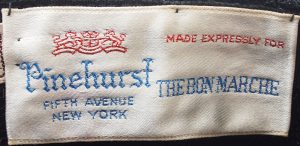The Bon Marché, a cornerstone of retail history in the Pacific Northwest, was founded in 1890 by Josephine and Edward Nordhoff in Seattle, Washington. The store’s name, which translates from French to “the good market,” was inspired by the renowned Parisian retailer Le Bon Marché, reflecting the Nordhoffs’ ambition to create a department store that emulated high standards of service and merchandising. With only $1,200 in savings, the couple opened their first dry goods store in a modest leased storefront.
In the years following its establishment, The Bon Marché grew rapidly, becoming a staple in the Seattle community. The couple worked tirelessly, often keeping the store open for long hours, to cater to the needs of the working-class clientele in the region. Josephine stocked shelves, cleaned the store and balanced the books. She learned the Chinook language in order to wait on Native American customers. Their dedication to customer service and quality merchandise quickly earned the store a loyal following.
As the 20th century progressed, The Bon Marché expanded beyond Seattle, opening branches in various cities throughout the Northwestern United States, including Boise (1937), Spokane (1947) and Tacoma (1964). This expansion reflected the store’s growing reputation and the increasing demand for its offerings. The department store became synonymous with value and quality, attracting shoppers who appreciated its solid middle-range pricing and diverse merchandise.
In the year 1929, a milestone occurred for The Bon Marché when it was acquired by Hahn Department Stores. Eventually, it became a part of Allied Stores, yet its distinct identity remained strong, and it continued to thrive, adapting to the evolving retail landscape and consumer preferences.
The Bon Marché experienced various name changes over the decades, dropping “Marché” from its title in the late 1970s, only to reinstate it by the mid-1980s. In 1989, Allied Stores merged into Federated Department Stores and Federated changed the store’s name to Bon-Macy’s in 2003. In 2005 Bon-Macy’s was called simply called Macy’s.
Written by denisebrain



